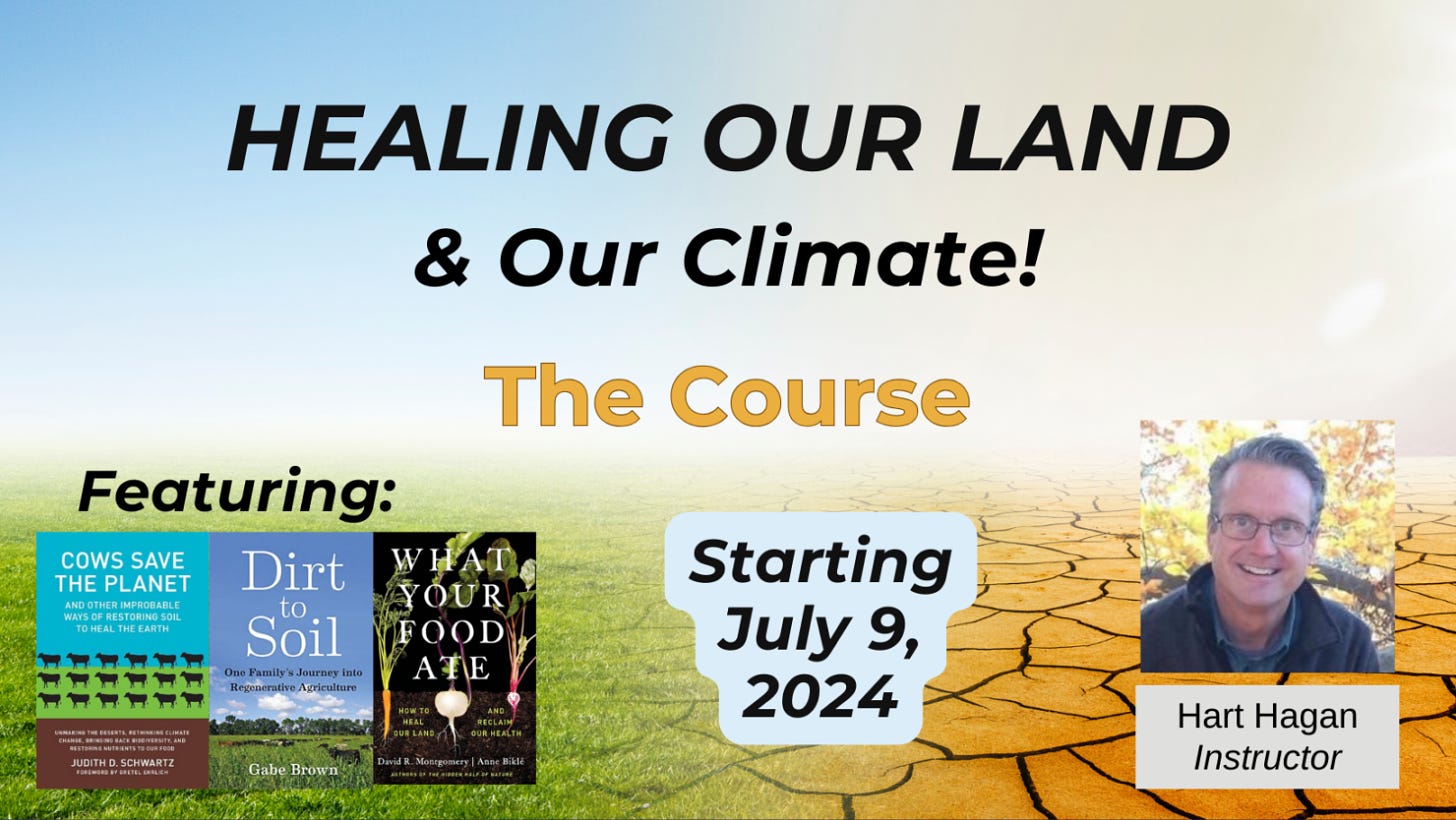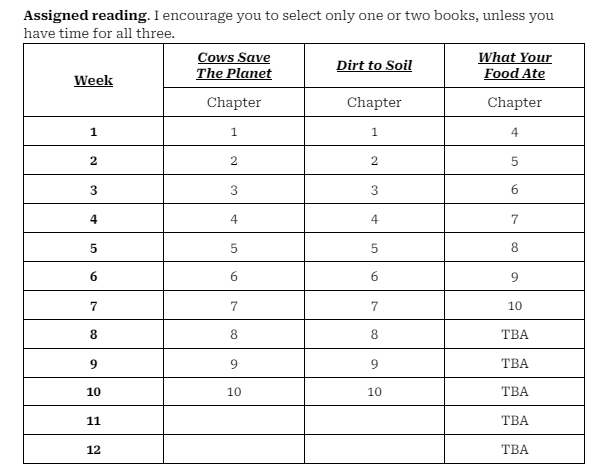Healing Our Land & Our Climate, The Course
Climate Reporter Hart Hagan offers a dynamic twelve week course in climate concepts, action and advocacy. Starts July 9, on Tuesdays at 12:00 or 7:00 Eastern Time
Check out the course here.
SYLLABUS
Title of Course: Healing Our Land & Our Climate
Subtitle: Climate Change, The Untold Story. Let’s get the real story, so we can make a real difference, real fast.
Instructor: Hart Hagan, Climate Reporter. YouTube Channel. Blog on Substack
Schedule: Class will meet on Tuesdays from July 9 through September 24. Students may choose between sessions at 12:00-1:30 PM or 7:00-8:30 PM (Eastern Daylight Time).
Location: Online
Fee: There is a small fee, but scholarships are available, and we don’t turn anyone away.
Register here:
https://bio4climate.org/course-offerings/healing-our-land-and-our-climate/
Executive Summary: This course will equip the student with a more complete understanding of climate change, together with tools for advocacy and action. You will learn how to make a difference in your own home landscape, as well as advocating for sensible public policies.
We will discuss these issues, as they arise in the assigned readings (see below).
How can we all make a difference?
Making a difference in our home garden and landscape.
Making a difference on our farms, as consumers and citizens.
Making a difference in our forests, as park stewards and advocates.
Our home landscape
How to minimize weeding and watering.
Step by step instructions
What are we going for? What are our goals?
Hart brings an abundance of pictures and experience.
Regenerative agriculture
What is regenerative agriculture?
Celebrity farmers to know, so we can all tell their stories.
Crop farming and climate change: the untold story.
The harms of chemical fertilizers.
How to fertilize without fossil fuels.
The wonders of cover crops. Why do we want farmers to use cover crops? Why don’t they?
How to manage pests without pesticides.
How does crop farming affect water quality?
What is the Plant Health Pyramid, and why should we care?
The Plant Health Pyramid can eliminate pesticides.
The Plant Health Pyramid can make farming profitable while minimizing fossil fuels.
Soil
The benefits of healthy soil, to your land value, to the climate, to wildlife, to water and to human nutrition.
How many of the world’s problems could we NOT solve if we attended to soil health?
The Five Principles of Soil Health
The Soil Food Web.
Ecosystems
How ecosystems cool the climate
How ecosystems absorb (or emit) carbon.
How ecosystems absorb (or emit) water.
How the loss of biomass (worldwide, by 50%) affects our climate.
Forests. How our forests interact with our climate.
Our water cycle. Evaporation condensation, cloud formation and precipitation.
What a forest becomes: the sponge, the cooler, the humidifier, the heat bank, the biotic pump, the wind break
Animals. What role do animals play?
What role do wild animals play?
What positive role can livestock play?
Are cattle always bad, or can they be very good?
Water & Climate
Water is a greenhouse gas. How to reduce it.
Evaporative cooling
Cloud cover
Plants & climate
Why should we add plant cover?
Where should we add plant cover?
How can we add plant cover, in our forests, farms and deserts?
How much plant cover do we need?
The greenhouse effect.
Incoming heat vs. outgoing heat. The excess is only 1%! Can we deal with 1%?
Is reducing carbon dioxide the quickest way--or the only way --to lower temperatures?
Oceans
What is the status of the oceans and why?
CO2 is a major cause of ocean acidification. Why is this a problem?
Just say no to deep sea mining!
How important are hot, bare surfaces
Bare surfaces include: pavement, concrete, bare dirt, sand.
Do bare surfaces contribute to the greenhouse effect?
How can we fix bare sur
Desertification
What is desertification?
What is the extent of desertification?
What is the cure for desertification?
Species extinction
Species extinction is clearer and more obvious than climate change.
Species extinction is harder to deny than climate change.
Species extinction shares many root causes with climate change.
Examples of species extinction:
The decline of insects
The decline of birds, wild mammals, large fishes & amphibians.
Does climate change cause extinction? Arguably, not so much, despite the media coverage to the contrary.
Solar, wind, electric vehicles.
How effective?
What are the ecological costs of these technologies?
Communication skills. The importance of Clear Messages
Bad messages are: unclear, nonobvious, dubious and tribalistic
Global warming is easy to argue with and easy to dismiss. If you alienate people on this issue, you have lost the right to talk with them about more obvious problems.
Good messages are: clear, obvious, hard to argue with, not tribalistic
Extinction of other species is clear and hard to argue with.
Ocean acidification from CO2 is clearer and less debatable than global warming.
Worldwide loss of biomass by 50% affects our climate.
Loss of forests affects our climate.
Water is a greenhouse gas
Learning outcomes:
Students will learn the content enumerated above.
Students will learn to take action in their home landscape or communities.
Students will learn to advocate sensible policies.
Assigned Reading (You are encouraged to select one or two books.)
Cows Save The Planet (and Other Improbable Ways of Restoring Soil to Heal the Earth) by Judith D. Schwartz
Dirt to Soil (One Family’s Journey into Regenerative Agriculture), by Gabe Brown
What Your Food Ate (How to Heal Our Land and Reclaim Our Health), by David R. Montgomery and Anne Bicklé
Register here:
https://bio4climate.org/course-offerings/healing-our-land-and-our-climate/




